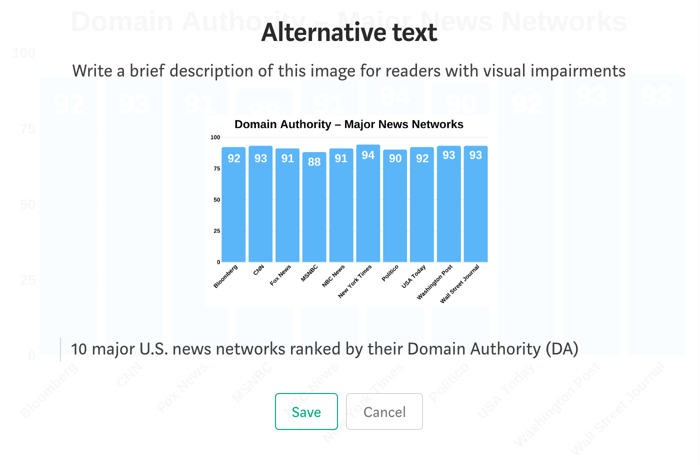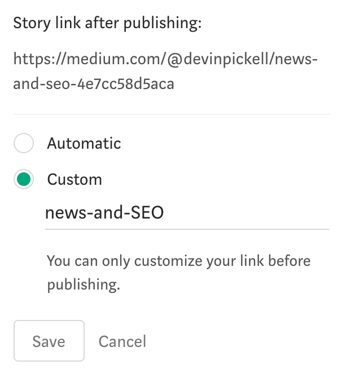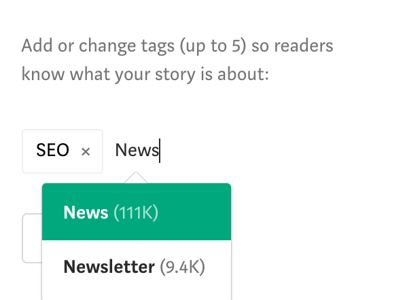What To Write About On Medium
Publishing your content to the Web is a great way to spread your tips and ideas, but it's also great for networking and building industry recognition.
In this tech-driven world, there are many options for publishing content. Some of the most commonly-used options today are website builders. This software allows businesses of all sizes to have powerful publishing capabilities with built-in SEO and analytics.

And while website builders have become the norm, many writers still utilize Web-based platforms for creating and publishing content.
I recently discussed the various benefits of writing an article on LinkedIn – like reaching the enormous community of professionals on the platform. But there's another great option for Web-publishing. It's called Medium.
Jump ahead to:
- 6 tips for writing on Medium
- Best practices for publishing
What is Medium?
Medium started as an invite-only Web-publishing platform in 2012 but quickly grew to prominence as blogging and content marketing grew in value. More people wanted a piece of the pie, and now Medium averages more than 200 million monthly visits.
The site is filled with both amateur and professional content. It has visual storytelling for publishers, and can even act as the main content hub for businesses that become Medium partners.
Anyone can join Medium for free and publish their thoughts, which makes the platform accessible for a wide range of users. In this guide, I'll discuss how to write on Medium and provide some tips for maximizing visibility.
How to write on Medium
After signing up for Medium, customizing your profile, and including a few words about yourself, it's time to start thinking about what you want to write.
Here are a few tips to consider:
1. Write on trending topics
Every article on Medium is tagged to its proper category, so this should help provide some inspiration on what to write. The current top five categories on Medium include:
- Ideas – The top category shouldn't come as a surprise, as Medium serves as a central space for idea and perspective sharing. Write about life lessons, business ideas, inspiration, innovation, and entrepreneurship.
- Politics – Politics have always been deeply important in our society. For some, politics have helped shape who they are today. In this category, you'll see topics ranging from the President, political candidates, economics, and election polling.
- Tech – One of Medium's largest reader bases is the tech-obsessed. Everything from startups, programming, blockchain, design and interface, and even social media is covered in this category.
- Entrepreneurship – This category goes hand-in-hand with ideas, however, more personal branding, marketing, self-improvement, and leadership skills are discussed here.
- Life – One of Medium's more general categories, expect to see a variety of content on writing techniques, poetry, love, passion, inspiration, personal development, and relationships.
Other popular topics to write about on Medium include money, culture, education, comics, photography, spirituality, fashion, music, humor, and others. As you can see, there are many diverse interests on the platform.
2. Avoid content marketing
Medium isn't exactly the spot to publish sales and marketing-heavy content. As a business, you can obviously include your links when necessary, but don't push your product or service too much within the content. As a matter of fact, Medium itself says this is generally frowned upon in their writing community.
An actionable way to engage with your readers on Medium is to encourage them to 'clap' if they found your article valuable. Claps are considered in Medium's ranking algorithm, and many claps can catapult your article in the eyes of more readers.
3. Don't mislead readers
Your goal as a writer should never be to mislead readers into clickbait, and you should double-down on this when it comes to Medium. Also, Medium is adamant about not peddling pseudoscience or bad health advice. As Siobhan O'Connor, VP of Editorial at Medium would say:
"Life's already too short to give people bad health advice."
4. Be authentic
It is strongly encouraged to post original insights and perspectives. Medium states aggregating content is frowned upon and plagiarizing other's work can lead to a few things. If caught plagiarizing, the original author could issue a cease and desist, request a reference link, force a complete rewrite, or negotiate a royalty.
The easy way to avoid all of this is simply not plagiarizing. Instead, map out your thoughts and conduct meaningful research before you begin typing. To learn more, read our guide on the five most common types of plagiarism today.
5. Reach the optimal content length
Your content doesn't need to be long-form and fully fleshed out. This is contrary to writing on LinkedIn, where long-form content in the range of 1,900 to 2,000 words seems to drive the most engagement. Short-form content that is actionable can perform just as well as full guides on Medium.
6. Optimize your headlines
Make your headlines clear and descriptive. This is especially true if you're trying to reach a wide audience. Unclear headlines could detract readers and may lead to higher bounce rates.
Publishing tips for Medium (how to get more visibility)
So, you have an idea of what to write and how to write it, but how do you get the most out of your content? How do you ensure people are seeing and reading your articles? It starts with on-page elements.
On-page writing elements for Medium
On-page writing elements refer to individual tweaks made to a piece of content to improve its searchability and user-friendliness. This is commonly done for SEO reasons, but Medium has on-page tweaks that can be made to increase visibility as well.
Add alt-text to your images
First off, you should already be using images in your Medium content, since articles with images have 94 percent more views than text-only articles. Next, be sure to include alternative text with these images. Alt-text makes images more accessible to sight-impaired users, hence, a greater audience.

Above is an example of alt-text. Be sure to be descriptive of the image so screen readers can accurately depict your image.
Use proper header tags
Most writers are aware of different sized headers and their readability, but did you know header tags are important for informing search engines of what your content is about? Using header tags properly in Medium is important

The large T signifies an H1 tag and should contain some variation of your target keyword. The small T signifies an H2 tag and should complement your H1.
For example, if your H1 is "How to write a marketing email," the H2 tags should be the individual steps of that process, i.e. "Write a captivating subject line" or "Be short and to the point."
Create a custom URL
Medium allows content creators to customize their story links before publishing. This can be done by tapping the More options menu and selecting Customize story link. Do so in a way that makes sense to the reader, but also has SEO value.

Customize links in a way that makes sense to the reader, but also has SEO value. If you have a keyword research tool or some SEO software, you can analyze which keywords have the highest volume and aim for one when customizing a URL.
Add a meta description
Publishing software typically requires you to enter a meta description before going live, although, Medium does not. Instead, you'll need to tap the More options menu and select Change display title/subtitle to begin customizing.

A meta description is an HTML tag, typically in 160 characters or less, that summarizes the content of your article. A good meta description is important for both readers (increases click-throughs) and search engines (increases ranking).
Add topic tags
If you really want to reach a variety of readers, consider tagging your content to relevant topics. You can do so by tapping the More options menu and selecting Change tags.

Add topic tags that are both high volume and relevant to your story. You can add up to five tags per article.
Related: Looking to publish a physical copy of your work? Consider the benefits of desktop publishing software to get the job done right.
Bonus tip when using Medium
Medium may be a Web-publishing platform for amateur and professional writers, but users should still look to expand their networks. This is another, less referenced way to maximize your profile's visibility.
See a publication that interests you? Follow it and engage with its day-to-day writers.
Clap for stories you enjoy to uplift them and share your thoughts in the comment section. Let the author hear your take on their story, and offer a new perspective if you feel it adds substance. The more you engage on Medium, the greater the likelihood other users become aware of your work.
For more online networking tips on platforms similar to Medium, check out our full guide for networking on LinkedIn. This could provide insight on how to leverage your network to its fullest potential.

Devin is a former senior content specialist at G2. Prior to G2, he helped scale early-stage startups out of Chicago's booming tech scene. Outside of work, he enjoys watching his beloved Cubs, playing baseball, and gaming. (he/him/his)
What To Write About On Medium
Source: https://learn.g2.com/how-to-write-on-medium
Posted by: bennettandonellove.blogspot.com

0 Response to "What To Write About On Medium"
Post a Comment